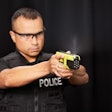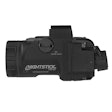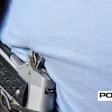Although I consider point shooting to be more natural than shooting with sights, there are definitely some tricks to it. I’ve been teaching people how to shoot this way for a long time and I’ve learned along the way that people “see” differently. Knowing how you see a target is the key to shooting accurately when point shooting.
Introductory Lessons
In October 1969, as the manager of the Seattle Gun Club, I began to teach what was then referred to as “instinctive shooting.” I had been working with the method for only a short time when one day I got a call from a fellow who wanted a shooting lesson. As a fledgling instructor in point, or instinctive, shooting, I thought I knew what I was doing. But I soon found out that one person’s shooting techniques don’t necessarily work for everyone else.
I scheduled a time and date and a few days later my new student showed up for his lesson. I went through my routine of introducing him to handling a BB gun. I described to him how I wanted him to “see” a 3.5-inch washer to gauge how best to aim.
The washer was thrown and he missed. I took the gun, cocked it, gave it back to him, and tried again. He missed again.
The sequence was repeated again and again and the man just couldn’t hit the target.
The student presented a problem and at the time I didn’t know how to fix it. My student finally asked me, “What am I doing wrong?” I had to admit that I didn’t have an answer. “I really don’t see why you’re missing the target, but let’s go have a cup of coffee,” I said. I figured there was no use beating a dead horse and taking a step back might be helpful to both of us.
A Different Point of View
On the way to the clubhouse, I began to think about checking what the shooter was seeing when he shot with both eyes open. Maybe I was missing something simple. But I needed to devise a way to test my hypothesis.
I looked around the on the ground, found a pull tab off a pop can, gave it to my student, and had him hold it out at arm’s length and line it up with my right eye, with both of his eyes open.
He did as I asked and from my point of view, looking back at the student, the pull-tab lined up to his left eye. I thought about it for a minute and the answer came. He had to be cross-firing to the left of the target. A gun fits if it shoots where you point it; it fits if it shoots where you’re looking; and it fits if it supports the controlling line of sight that’s looking where you want the shot to go.
I then suggested the BB gun be shifted to the left shoulder. This is a most difficult change to make, and the older you are the harder it is. But it was worth a try.
I instructed my student to move the air rifle to his left side and had him move the gun up to his cheek and back down several times to get him accustomed to the motion on his weak side. Then we tried again.
The 3.5-inch washer was thrown, and the student hit it. Again, the target was thrown and he continued to hit the target. I changed to the smaller 2.5-inch target and it made no difference in the shooter’s skill. As long as he continued to see the smaller target the same way he did the larger target, he couldn’t miss.
I’d discovered the secret to my student’s success in point shooting the shotgun: he was a cross-dominant shooter.
I changed the student from the BB gun to the Remington 1100 shotgun without a bead on the barrel and he broke 95 percent of the targets thrown.
From that day on I’ve never begun a lesson in point shooting without testing how a student will see with both eyes open to eliminate the probability of cross-firing. This applies to pointing both handguns and shotguns.
Since my first experience in finding a cross-dominant person, I have also found 15 different eye/hand combinations, most of which can affect a person’s ability to shoot straight.
Making a Mark
Sometimes all you need are a little inspiration and determination to motivate success. I found both while sitting on my couch one day. It doesn’t sound like an auspicious beginning, but it was what I needed.
Back in the year 1970, I was watching “Gunsmoke,” one of my favorite programs on TV. Matt Dillon got into a gunfight out in the front of the Longbranch Saloon. It was a standoff between Matt and a real bad hombre. When the bad guy went for his gun, as quick as lightning Matt drew and shot the fellow stone dead with a single shot.
It got me to thinking about why one shooter is so much better than another and I thought I could figure out why. I knew Matt Dillon was confident, fearless, brave, and knew how to shoot straight.
The next day I bought my first handgun, a Model 28 Smith & Wesson with a six-inch barrel that would handle .38 caliber ammunition. My initial goal was to learn to shoot as well at a standing target as the greatest of the great handgun shooters, Ed McGivern.
Here Goes Nothing
I didn’t know how to hold the revolver, so I got the grip from Border Patrol Agent Bill Jordon’s book, “No Second Place Winner.” I didn’t know exactly how to pull the trigger, but I figured it had to be smooth, as the shots had to be very accurate. I practiced dry firing for a short time with a penny on the rib of the gun until the penny would stay in place from start to finish. I also learned that the stronger I held the gun, the steadier the penny became and the fewer vibrations I would send to the end of the barrel.
I learned to hold my arms at a most natural, isosceles position at chest height, as I knew I would have more strength in controlling recoil, especially with two hands on the gun. This is a natural pointing position.
With all my ideas in order, I gathered up my handgun and three bobber targets. One with a 3.5-inch paper circle on the chest, one with a 2.25-inch fluorescent paper circle on the chest of the target, and the last one with a .24-inch piece of paper on the center of the chest.
The following day, with 50 rounds of .38 caliber wadcutter ammunition, I headed down an old logging road. I soon stopped at a large Douglas fir tree and nailed up the first target with a 3.5-inch fluorescent paper circle on it. I then paced off a distance of 15 feet, the same distance McGivern shot from when he shot six shots and covered five of them with a playing card in 2/5ths of a second. At that time I didn’t care about the speed of fire. I just wanted to know where skill came from and I thought maybe the secret would lie in the lessons I gave shotgun shooters.
Four days later, after shooting 50 shots per day, I found the secret to McGivern’s accuracy. On the fifth day, I set up a fresh target and shot five bullets touching at a distance of 15 feet. I did the same on the sixth and seventh days and by then I could do it without having to think about what I had to do in order to fire the bullets very accurately. Once you know how to shoot skillfully, it will be second nature for a lifetime.
Since my early days in learning to point shoot a handgun I have spent 31 years training U.S. Border Patrol agents and other law enforcement officers throughout the United States. In 1991, I started a “Hole in One Club,” recognizing those law enforcement officers who shoot five bullets touching onto a steel target without the use of sights. As of May 2005, the club had a membership of 1,241.
Jim Gregg runs Jim Gregg’s Shooting Schools in Moses Lake, Wash. He recently published a guide to point shooting, “The Gregg Method of Fire Control.”
Getting the Point
Although I consider point shooting to be more natural than shooting with sights, there are definitely some tricks to it. I’ve been teaching people how to shoot this way for a long time and I’ve learned along the way that people “see” differently. Knowing how you see a target is the key to shooting accurately when point shooting.















